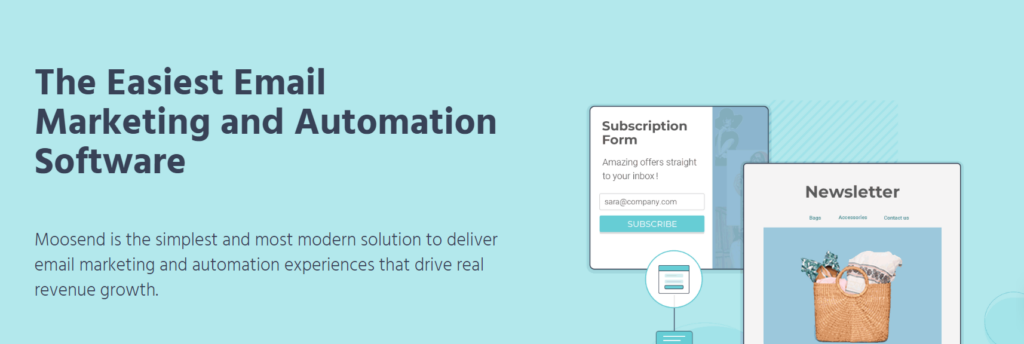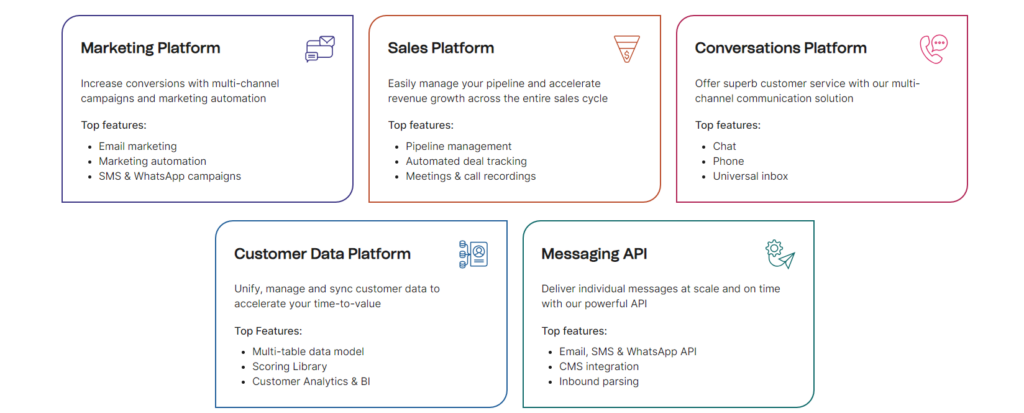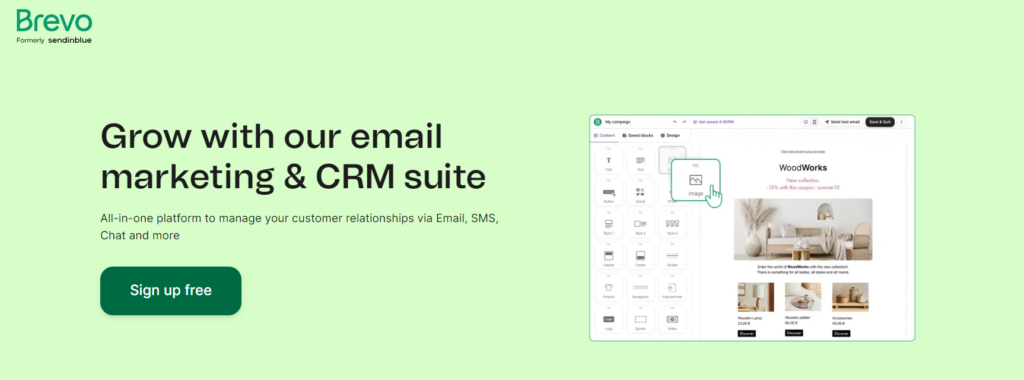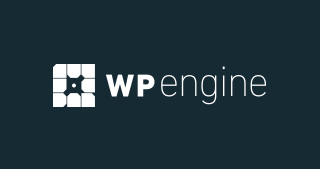Email marketing remains one of the most powerful tools for businesses to engage with their audience, drive conversions, and build relationships.
However, the success of an email marketing strategy depends largely on the platform you choose. Moosend and Sendinblue are two well-known email marketing solutions that cater to businesses of all sizes.
Both platforms offer comprehensive email marketing features, but they differ in their pricing, automation, and additional tools.
In this article, we’ll provide a detailed comparison of Moosend vs. Sendinblue, exploring their key features, pricing plans, strengths, and weaknesses. This analysis will help you decide which platform aligns better with your business goals.
Choosing the right email marketing platform is crucial for businesses seeking to enhance their communication strategy, automate workflows, and achieve a higher ROI.
Moosend and Sendinblue are both excellent options, but they serve slightly different needs.
Moosend is widely recognized for its user-friendly interface, affordable pricing, and powerful automation features. It is particularly popular among small businesses and startups looking for an easy-to-use platform that doesn’t require extensive technical expertise.
On the other hand, Sendinblue is known for offering a more comprehensive marketing suite that goes beyond email marketing. It provides SMS marketing, transactional emails, and marketing automation, making it a great choice for businesses with more diverse marketing needs.
Let’s dive into a detailed comparison to understand which platform might be a better fit for you.
Overview of Moosend and Sendinblue
Overview of Moosend

Moosend is a cloud-based email marketing platform that simplifies the process of creating, sending, and managing email campaigns. Founded in 2011, Moosend has gained traction due to its straightforward interface, advanced automation tools, and competitive pricing.
Moosend’s primary focus is on email marketing and automation, offering a range of templates, real-time analytics, and segmentation tools to help businesses create personalized email experiences.
Moosend integrates seamlessly with popular e-commerce platforms like Shopify and WooCommerce, allowing online retailers to automate abandoned cart emails, product recommendations, and transactional messages.
Additionally, Moosend offers a free plan, making it a cost-effective solution for businesses just starting out.
Overview of Sendinblue

Sendinblue is a versatile marketing platform that goes beyond email marketing to include SMS marketing, live chat, and CRM functionalities.
Launched in 2012, Sendinblue is widely regarded for its powerful automation features and diverse range of communication tools.
While its email marketing capabilities are strong, Sendinblue’s appeal lies in its ability to combine multiple marketing channels in one platform.
Sendinblue is a great option for businesses looking to automate more than just email campaigns. Its intuitive automation builder allows users to create complex workflows that span multiple channels, including SMS and chat.
In addition, Sendinblue offers advanced reporting, helping businesses monitor and improve their marketing strategies in real time.
Features Comparison: Moosend vs. Sendinblue
1. Email Editor
Moosend:

Moosend features an intuitive drag-and-drop editor that allows users to create beautiful, professional emails without any coding skills.
The platform offers a variety of customizable templates and design elements, making it easy to craft personalized email campaigns. Moosend’s email editor is straightforward and ideal for users who want to design their emails quickly and efficiently.
Sendinblue:

Sendinblue also provides a drag-and-drop email editor, but with more advanced customization options. It offers over 60 responsive templates and allows users to easily tweak fonts, colors, and layouts.
In addition to email design, Sendinblue enables users to personalize content based on specific criteria like user location or behavior, ensuring that every email resonates with the recipient.
2. Automation Workflows
Moosend:
Moosend’s automation workflows are a standout feature. The platform enables users to create sophisticated automation sequences triggered by specific actions, such as user sign-ups, abandoned carts, or purchases.
Moosend’s workflow builder is visual and easy to navigate, allowing even beginners to set up complex automations. Common use cases include sending welcome emails, product recommendations, and event-triggered emails.
Sendinblue:
Sendinblue offers equally impressive automation features, but with more flexibility. In addition to email workflows, Sendinblue’s automation builder supports multi-channel workflows, combining email, SMS, and chat into a single sequence.
For example, you can send a follow-up SMS after a user receives an email or send a chat notification when a customer completes a purchase. This makes Sendinblue a more versatile option for businesses looking to expand their communication channels.
3. Segmentation
Moosend:
Moosend excels in list segmentation, allowing users to divide their email lists based on various criteria like behavior, demographics, and purchasing history.
This ensures that your emails are highly relevant to each recipient, leading to better engagement. Moosend’s segmentation capabilities are easy to use and can be integrated seamlessly with automation workflows.
Sendinblue:
Sendinblue offers advanced segmentation features, allowing users to create highly targeted email campaigns.
Segments can be based on user activity, engagement, purchase history, or custom fields. Sendinblue also allows for real-time segmentation, ensuring that your lists are always up to date based on the latest user interactions.
4. SMS Marketing
Moosend:

Moosend is primarily focused on email marketing and does not offer built-in SMS marketing features. Users looking for SMS marketing capabilities would need to integrate third-party tools to manage this aspect of their campaigns.
Sendinblue:

Sendinblue’s SMS marketing features are a key differentiator. It allows businesses to send transactional and promotional SMS messages alongside their email campaigns.
This feature is especially useful for businesses that want to expand their communication channels beyond email and engage with customers via text messages.
5. Transactional Emails
Moosend:
Moosend supports transactional emails, allowing businesses to send order confirmations, shipping notifications, and account-related updates.
These emails can be automated based on specific triggers, and Moosend provides detailed reporting on their performance.
Sendinblue:
Sendinblue also excels in transactional emails. Its transactional email API enables businesses to send personalized messages at scale, ensuring that important communications like order confirmations or password resets reach users instantly.
Sendinblue also provides dedicated IPs for transactional emails, ensuring deliverability and reducing the risk of emails landing in the spam folder.
6. CRM Features
Moosend:
Moosend does not offer built-in CRM functionalities, focusing solely on email marketing and automation. However, it integrates with popular CRM systems, allowing businesses to connect their email marketing campaigns with their existing customer data.
Sendinblue:
Sendinblue includes CRM tools, allowing businesses to manage customer relationships directly within the platform.
Users can track leads, manage contacts, and even assign tasks to team members, making it a comprehensive solution for businesses looking to integrate their email marketing with CRM.
7. Landing Pages
Moosend:
Moosend includes a landing page builder that allows users to create high-converting landing pages for their email campaigns.
The drag-and-drop editor makes it easy to design landing pages without needing web development skills, and it integrates seamlessly with Moosend’s email marketing tools.
Sendinblue:
Sendinblue also provides a landing page builder, but it offers more advanced customization options and templates.
Sendinblue’s landing pages are mobile-responsive and can be personalized based on user behavior or segmentation, which is a great advantage for businesses looking to optimize their conversion rates.
Pricing Comparison
Pricing is a key factor for many businesses when choosing between email marketing platforms. Here’s how Moosend and Sendinblue compare in terms of cost:
Moosend Pricing:

- Free Plan: Moosend’s free plan allows users to send unlimited emails to up to 1,000 subscribers. It includes basic features like automation workflows and email templates.
- Pro Plan: Starting at $9 per month, the Pro plan scales based on the number of subscribers and includes landing pages, transactional emails, and phone support.
- Enterprise Plan: Custom pricing is available for larger businesses requiring advanced features such as dedicated account management, custom reporting, and priority support.
Sendinblue Pricing:
- Free Plan: Sendinblue’s free plan allows users to send up to 300 emails per day to an unlimited number of contacts. This plan includes basic email marketing and automation features but limits daily email volume.
- Lite Plan: Starting at $25 per month, the Lite plan includes advanced features like A/B testing, reporting, and support for more email volume.
- Premium Plan: Starting at $65 per month, the Premium plan includes additional features like multi-channel marketing, landing pages, and access to advanced automation.
- Enterprise Plan: Custom pricing is available for large businesses that require advanced features like dedicated IPs, priority support, and personalized onboarding.
FAQ
1. Which platform offers better automation?
Both Moosend and Sendinblue offer powerful automation features, but Sendinblue’s multi-channel automation capabilities give it an edge.
2. Does Moosend offer SMS marketing?
No, Moosend does not have built-in SMS marketing features, while Sendinblue does.
3. Is Moosend more affordable than Sendinblue?
Yes, Moosend’s pricing is generally more affordable, especially for small businesses.
4. Can I send transactional emails with Sendinblue?
Yes, Sendinblue offers robust transactional email services, including a dedicated API.
Conclusion
When comparing Moosend vs. Sendinblue, it’s clear that both platforms offer strong email marketing features, but they cater to slightly different business needs. Moosend is an excellent choice for businesses seeking a cost-effective, easy-to-use email marketing platform with powerful automation capabilities.
Its affordable pricing, intuitive email editor, and real-time analytics make it especially attractive to small and medium-sized businesses looking to grow their email marketing efforts without breaking the bank.
Moosend’s free plan and straightforward features are ideal for businesses that primarily focus on email marketing and require a budget-friendly solution.
On the other hand, Sendinblue goes beyond email marketing by offering a comprehensive marketing suite, including SMS marketing, CRM functionalities, and multi-channel automation.
This makes Sendinblue a more versatile platform, suitable for businesses that want to integrate multiple communication channels and manage customer relationships in one place.
While Sendinblue’s pricing is higher, its advanced features—such as multi-channel workflows, transactional emails, and a dedicated CRM system—justify the cost for businesses with more complex marketing needs.
In summary, Moosend is perfect for businesses primarily focused on email marketing and looking for an affordable solution with great automation tools.
Sendinblue is a better fit for businesses that require a multi-channel marketing approach, including SMS and CRM, and are willing to invest in more advanced features to support their marketing strategies.
The choice ultimately depends on your business’s size, goals, and the level of functionality you need from your marketing platform.



